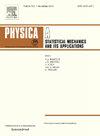Anomalous diffusions of the composite processes: Generalized Lévy walk with jumps or rests
IF 2.8
3区 物理与天体物理
Q2 PHYSICS, MULTIDISCIPLINARY
Physica A: Statistical Mechanics and its Applications
Pub Date : 2025-03-08
DOI:10.1016/j.physa.2025.130503
引用次数: 0
Abstract
Composite processes appear in a wide field, such as biology, ecology and natural science, so it is necessary to establish corresponding models to describe them. This manuscript builds up two two-mode random walk models which are the generalized Lévy walk with jumps (GLWJ) model and the generalized Lévy walk with rests (GLWR) model. The GLW processes in these two models will be interrupted by jumps and rest events, respectively, and move at a new velocity which is coupled with the motion time. The motion time and waiting time densities follow power-law forms and the jump density follows a Lévy form. We discuss the diffusive behaviors by analytically calculating the mean square displacement (MSD) and numerically simulating the probability density function (PDF). The results reveal their MSDs in both models exhibit crossover phenomena during the evolution processes. Meanwhile, the diffusion type of the GLWJ can be determined by either the largest exponent term or the largest pre-coefficient term. However, since the GLWR does not have random fluctuations from another mechanism that competes with the GLW. Without considering the scales of two time density functions, its diffusion type is determined only by the largest exponent team. The studies of these two models provide theoretical guidances for practical observations of some complex processes such as intermittent search strategies, human activity patterns in cities and cold atom fluctuations.
复合过程的异常扩散:有跳跃或休息的广义lsamvy行走
复合过程出现在生物学、生态学和自然科学等广泛的领域,因此有必要建立相应的模型来描述它们。本文建立了两种双模随机行走模型,即广义lsamvy带跳跃行走(GLWJ)模型和广义lsamvy带休息行走(GLWR)模型。在这两种模型中,GLW过程将分别被跳跃和静止事件打断,并以与运动时间耦合的新速度运动。运动时间和等待时间密度遵循幂律形式,跳跃密度遵循lsamvy形式。我们通过解析计算均方位移(MSD)和数值模拟概率密度函数(PDF)来讨论扩散行为。结果表明,两种模型的MSDs在演化过程中均表现出交叉现象。同时,GLWJ的扩散类型可以通过最大指数项或最大预系数项来确定。然而,由于GLWR不存在与GLW竞争的其他机制的随机波动。在不考虑两个时间密度函数的尺度的情况下,其扩散类型仅由最大指数组决定。这两个模型的研究为间歇性搜索策略、城市人类活动模式和冷原子涨落等复杂过程的实际观测提供了理论指导。
本文章由计算机程序翻译,如有差异,请以英文原文为准。
求助全文
约1分钟内获得全文
求助全文
来源期刊
CiteScore
7.20
自引率
9.10%
发文量
852
审稿时长
6.6 months
期刊介绍:
Physica A: Statistical Mechanics and its Applications
Recognized by the European Physical Society
Physica A publishes research in the field of statistical mechanics and its applications.
Statistical mechanics sets out to explain the behaviour of macroscopic systems by studying the statistical properties of their microscopic constituents.
Applications of the techniques of statistical mechanics are widespread, and include: applications to physical systems such as solids, liquids and gases; applications to chemical and biological systems (colloids, interfaces, complex fluids, polymers and biopolymers, cell physics); and other interdisciplinary applications to for instance biological, economical and sociological systems.

 求助内容:
求助内容: 应助结果提醒方式:
应助结果提醒方式:


